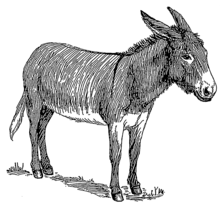Donkey set
In linguistics is donkey sentence (English: donkey sentence ) the technical term for a class of sets in which pronoun is different from traditional bond theory behave. The name goes back to examples in medieval logic in which donkeys play a role. Donkey sentences were brought into the modern philosophical and linguistic discussion by Peter Geach . They are examined primarily in terms of formal semantics .
definition
Donkey clauses appear in two constructions: conditional clauses like ( 1) and relative clauses like (2).
- If a farmer has a donkey, he beats it.
- Every farmer who owns a donkey beats him.
The theoretically problematic constellation consists of the indefinite noun phrase (e.g. a donkey ) and the pronoun (e.g. him ). While from a syntactic perspective the pronoun is not bound by the noun phrase, semantically it behaves like a bound pronoun. Furthermore, the resulting reading of (1) and (2) is one that generalizes about all farmers and donkeys: The sentences express that all farmers beat their donkeys. Formally, this can be expressed using an universal quantifier , although indefinite noun phrases are usually analyzed as existential quantifiers . The problem for linguistics is to explain why donkey sentences are understandable, despite their deviations from classical logical analyzes, and how they get their meaning.
Theoretical approaches
Donkey sentences have sparked numerous discussions in linguistic and philosophical research. Two large families of theories are dynamic semantics and e-type theory. Recent research deepens and compares these approaches and deals with new empirical material.
Dynamic semantics
The dynamic semantics for donkey sentences goes back to the work of Irene Heim and Hans Kamp, who simultaneously developed similar approaches for the analysis of donkey sentences independently of one another. It differs from static semantics in that sentences in it are not only dependent on the context, but also change it at the same time. This allows the existential quantifier of the donkey sentence to bind the pronouns in the semantics, even if they remain syntactically unbound. Approaches in dynamic semantics are characterized by the fact that they solve the problem of donkey sentences through a new analysis of the indefinite noun phrase. A compositional variant of dynamic semantics was first developed by Groenendijk and Stokhof.
E-type theory
The E-type theory goes back to the work of Robin Cooper and Gareth Evans . It was initially replaced by the dynamic approaches, but brought back into the discussion through the modern interpretation of Paul Elbourne. The E-type theory analyzes pronouns as covert definite noun phrases and thereby tries to solve the problems of donkey sentences.
Recent research
In addition to the fundamental work in the above-mentioned theories, linguistics has shown, among other things, that donkey sentences not only have readings with universal quantification, but also have a number of other readings. More recent work also deals with the interaction of donkey sets and counterfacticity .
Individual evidence
- ↑ Gualterus Burlaeus: From the purity of the art of logic . Ed .: Peter Kunze. Meiner, 1988 (Original title: De puritate artis logicae tractatus longior . 1328.).
- ^ Peter Geach: Reference and Generality . Cornell University Press, 1962.
- ↑ Jon Barwise, Robin Cooper: Generalized Quantifiers and Natural Language . In: Linguistics and Philosophy . No. 4, 1981, pp. 159-219.
- ^ A b Irene Heim: The Semantics of Definite and Indefinite Noun Phrases . University of Massachusetts Amherst PhD dissertation, 1982.
- ↑ Hans Kamp: A theory of truth and representation . In: Formal Semantics. The essential readings . 1981, pp. 189-222.
- ↑ Jeroen Groenendijk, Martin Stokhof: Dynamic Predicate Logic . In: Linguistics and Philosophy . No. 14.1 , 1991, p. 39-100 .
- ^ Robin Cooper: The interpretation of pronouns . In: Syntax and Semantics . No. 10 , 1979, p. 61-92 .
- ↑ Gareth Evans: Pronouns, quantifiers and Relative Clauses . In: Canadian Journal of Philosophy . No. 7.3 , 1977, p. 467-536 .
- ↑ Paul Elbourne: Situations and individuals . MIT Press, 2005.
- ^ Lenhart Schubert, Francis Pelletier: Problems in the Representation of the Logical Form of Generics, Plurals, and Mass Nouns . In: Ernest Lepore (Ed.): New Directions in Semantics . Academic Press, 1987, pp. 385-451 .
- ↑ Bart Geurts: Donkey Business . In: Linguistics and Philosophy . No. 25 , p. 129-156 .
- ↑ Irene Heim: E-type Pronouns and Donkey Anaphora . In: Linguistics and Philosophy . No. 13 , p. 137-177 .
- ^ Adrian Brasoveanu: Donkey Pluralities. Plural Information States versus Non-Atomic Individuals . In: Linguistics and Philosophy . No. 31 , 2008, p. 129-209 .
- ↑ Robert van Roij: Free Choice counterfactual Donkeys . In: Journal of Semantics . No. 23 , 2006, p. 383-402 .
- ^ Yingying Wang: Counterfactual Donkey Sentences. A reply to van Rooij . In: Journal of Semantics . No. 26 , 2009, p. 317-328 .
- ^ Andreas Walker, Maribel Romero: Counterfactual Donkeys. A Strict Conditional Analysis . In: Proceedings of SALT . tape 25 , 2015, p. 288-307 .
